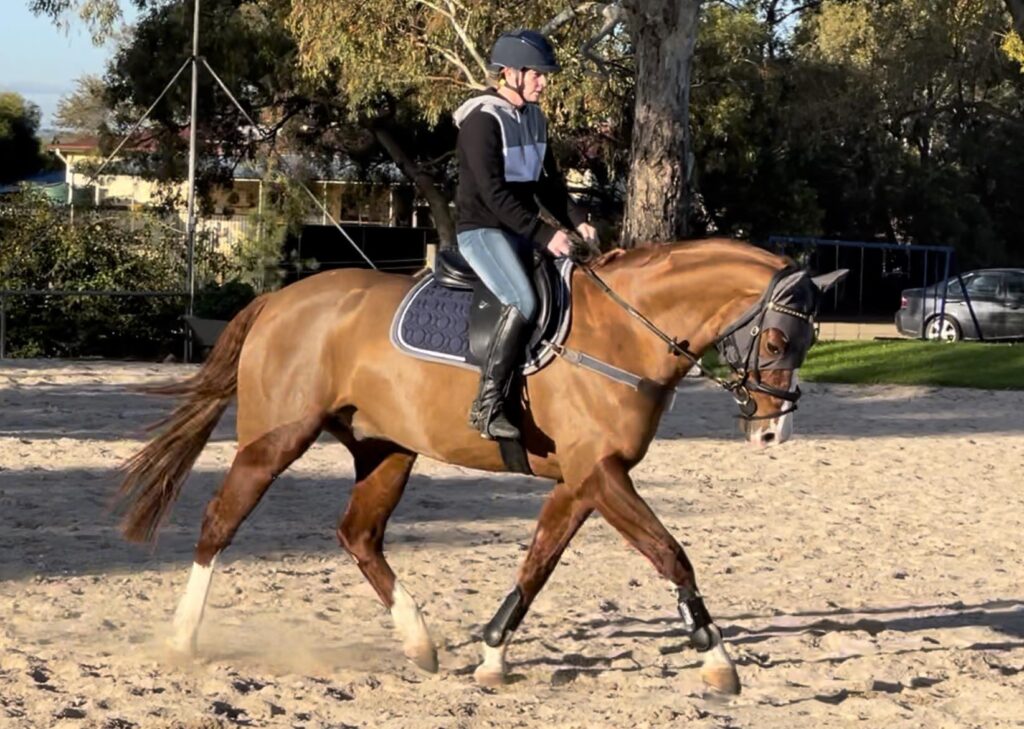Anettte Wilson | 0447337276
Anettte Wilson | 0447337276

Do You Repeat Your Movement Patterns Over And Over?
Does Your Instructor Repeat The Same Words?
As a Physiotherapist with 30 years of experience as a treating therapist, I see the attachment to habits as a major block to retraining posture and movement patterns. I witness the attachment to habits and the unwillingness to change or retrain movement patterns as an excuse. This acceptance of “what is” is a major block in people improving their flexibility, strength, movement patterns, and ultimately their posture.
I see it in both old and younger people. I see the same attachments in the horse rider. I hear comments like..’ I always do that”, “I have a swayback”, “I can’t change now”, “I’m too old”.”My balance has always been poor”, “I have no coordination”. “I’m tired”…that one is a poor excuse! The skills required for horse riding are not only movement, strength, and flexibility but also the skill to be able to move the body parts independently.
If a rider hangs onto old movement patterns then, learning new ones specific to riding can be testing. The horse rider does need to be able to apply specialized movement patterns for the best application of aids to the horse. For example, a half-halt requires a gentle movement of the rein with gentle leg pressure.
This rein aid can be applied through a small bend in the wrist, a small flexion of the elbow, a small backward movement of the shoulder, or even a small back tilt of the trunk. All these little movements will result in a slight movement backward of the rein and hence the bit. All can be applied and all can be correct but the rider needs to have the skill to apply only one or the half-halt becomes a tug on the bit.
The pressure against the horse’s side may come from the heel, or the lower leg increasing pressure against the horse, or the seat may tilt down increasing the pressure of the leg or the whole leg may well be applied with more pressure to the horse’s side.
All of these movement patterns” apply more leg” to the horse. Again if the rider does not understand or have the skill to apply “the “aid they want then the horse will always be confused. Spurs and strong bits are weapons in the wrong hands and the horse is the victim, as seen in the photo here
A confused horse may resist through the reins, go sideways, rush off, pull on the bit, buck, become too sensitive, or in many others just dull to the aids and heavy to do anything with. This simple example applies to every movement and every aid you want from your horse, you are the trainer the horse is the student, so imagine how confusing the mixed signals are and hence the reaction you get at times.
So back to my point, a horse rider is always learning new skills to become a better rider. The first lesson is to understand the horse riding posture and movement patterns required. I believe a horse rider must know their own body concerning flexibility, strength, power, and coordination. If you have a deficiency in any aspect of these skills then learn how to fix them.
The first lesson is to understand the horse riding posture and movement patterns required. I believe a horse rider must know their own body concerning flexibility, strength, power, and coordination. If you have a deficiency in any aspect of these skills then learn how to fix them. The sloth posture at rest becomes the riding posture in action. The habits you have at work, at rest, and every time you move will affect your riding posture and your skill. If you are stiff through the lower back, every pace will jar you and inhibit your core.
This will create a block in your movement patterns and the horse with definitely block back. If you are unable to use your shoulder independent of your elbow and wrist you will always tend to pull through a bent wrist. Your horse will become heavy on the bit. If your core is not coordinated the sitting trot and canter will never be smooth. So how do you fix it? Well, self-testing your muscles, flexibility, and symmetry is a start.
Training your weak areas as well is a must. Learning how to engage the core and how to use it in the saddle is essential. Treating back pain or rehabbing injuries properly is always necessary. If a brace is a solution then buy one and use it. They can be very useful tools in retraining bad posture. I have used both a shoulder brace and a back brace at various times during my career both at work and when riding.
If you are unable to use your shoulder independent of your elbow and wrist you will always tend to pull through a bent wrist. Your horse will become heavy on the bit. If your core is not coordinated the sitting trot and canter will never be smooth. So how do you fix it? Treating back pain or rehabbing injuries properly is always necessary.
For those interested in my Applied Posture Riding Membership Program can teach you all of the above.
I have a Youtube channel with many videos to check out here.
Look Good Ride Well Dismiss